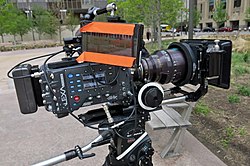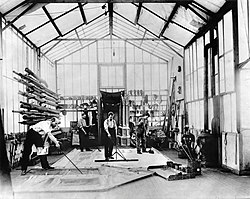Cinematography
Cinematography is the recording of photographic images for cinema. Like still photography, it includes making lighting and camera choices. However, the pictures move. A person who specializes in cinematography is called a cinematographer.
Etymology
The word cinemetography come from the Greek words kinema - κίνημα, meaning "movement" and graphein - γράφειν meaning "to write".
Uses
Movie cameras use a lens to focus reflected light from objects. This light makes an image that is used by an image sensor or a light-sensitive material inside a movie camera. These images are created one after another and saved for later processing and viewing as a motion picture. Images captured with photographic emulsion create a series of invisible images on the film stock. Chemicals are used to "developed" this into visible images. The images on the film stock are projected for viewing the motion picture.
When using an electronic image sensor, the image creates an electrical charge for each pixel in the image. This kind of camera is a video camera. These are processed and stored in a video file. This file can later be processed or shown.
Cinematography is used in many fields of science and business as well as for entertainment and mass communication.
Cinematography Media
Arri Alexa, a digital movie camera
An Eadweard Muybridge sequence of a horse galloping
Roundhay Garden Scene (1888), the world's earliest surviving motion-picture film
Annabelle Serpentine Dance, hand-tinted version (1895)
Georges Méliès (left) painting a backdrop in his studio
Live recording for TV on a camera with a Fujinon optical lens
Camera on a small motor vehicle representing a large one




